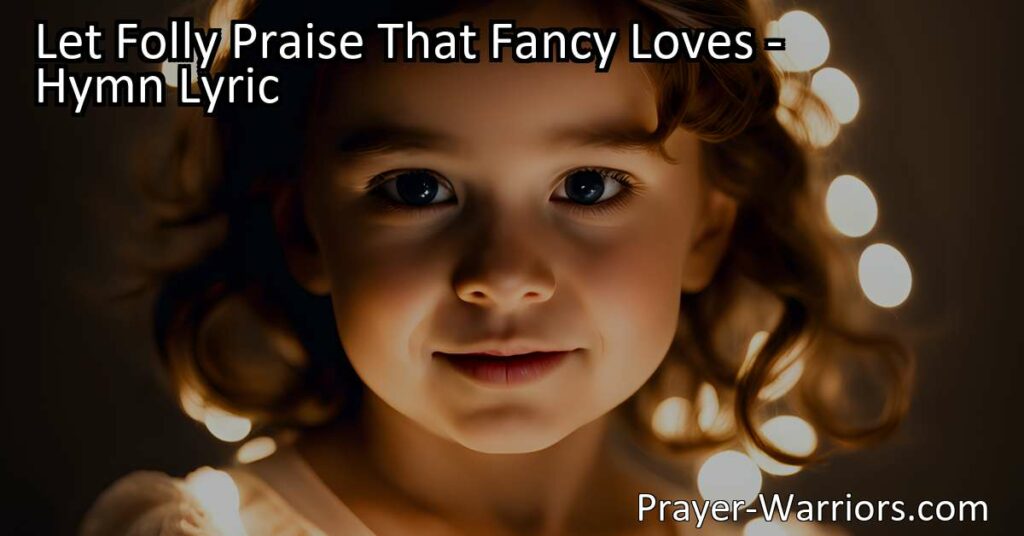Let Folly Praise That Fancy Loves – Hymn Lyric
“Let Folly Praise That Fancy Loves” celebrates the purity and virtues of a child whose heart, words, and actions remain untarnished. This hymn emphasizes the power of innocence and the importance of unconditional love and devotion. It reminds us to embrace love, virtue, and goodness, and to find purpose in cherishing and admiring the child who embodies these qualities.
Table of Contents
Let Folly Praise That Fancy Loves – Hymn Lyric
Let folly praise that fancy loves;
I praise and love that child whose heart
No thought, whose tongue no word
Whose hand no deed defiled.
I praise him most, I love him best;
All praise and love are his.
While him I love, in him I live,
And cannot live amiss.
Love’s sweetest mark, laud’s highest theme,
Our most desired light.
To love him life, to leave him death,
To live in him delight.
He mine by gift, I his by debt,
Thus each to other due:
First friend he was, best friend he is;
All times will find him true.
Though young, yet wise, though small, yet strong,
Though man, yet God he is;
As wise he knows, as strong he can,
As God he loves to bless.
His knowledge rules, his strength defends,
His love doth cherish all;
His birth our joy, his life our light,
His death our end of thrall.
Meaning of Let Folly Praise That Fancy Loves
Let Folly Praise That Fancy Loves: Embracing the Pure Heart and Virtuous Actions
Introduction:
In this hymn, we celebrate the virtues of a child whose heart remains untainted by worldly desires, whose words are pure, and whose actions are righteous. This child represents the epitome of love and goodness that we should all strive for. Let us delve deeper into the meaning behind these words and explore the profound message they convey.
1. The Power of Innocence and Virtue:
The hymn highlights the significance of innocence and virtue by contrasting them with worldly folly. While folly may be praised by some, it is the child’s pure heart that truly deserves admiration. It is a heart untouched by wickedness, a heart that treasures love and goodness above all else.
2. Unconditional Love and Devotion:
The hymn emphasizes the unwavering love and devotion we should have towards this child. By loving and cherishing this child, we find purpose in life, and we become incapable of straying from the path of righteousness. This devotion towards the child symbolizes the deep love and respect we should have for all that is good and pure in the world.
3. Love as the Greatest Virtue:
Love is described as the highest theme and sweetest mark. It is the most desired light that guides our way. To love this child is to truly live, and to leave this child would be akin to experiencing death. Love, therefore, becomes the essence of our existence, the driving force that brings us fulfillment and joy.
4. Mutual Bond and Responsibility:
The hymn speaks of a mutual bond and responsibility that exists between the child and those who love and admire him. It is not a one-sided relationship, but rather a debt owed by each party involved. The child is seen as a gift to us, and we, in turn, owe our devotion, loyalty, and love to this remarkable child.
5. Friend, Wisdom, and Strength:
Though young in age, the child possesses wisdom beyond his or her years. The child’s strength goes beyond the physical; it is a strength that comes from within, a strength derived from a divine source. The child is not only a friend but the best friend, who remains true and trustworthy at all times. Through the child, we see a reflection of true friendship and loyalty.
6. The Divine Element:
The hymn acknowledges that the child is not just a mere mortal but also a god-like figure. He or she possesses the qualities of divinity knowledge, strength, and love. This divine nature allows the child to guide and protect us, to become our ultimate source of sustenance and inspiration.
7. Birth, Life, and Death:
The birth of this child is a cause for great joy and celebration. The child’s mere existence brings light into our lives, illuminating our way and filling our hearts with happiness. Furthermore, the child’s life is described as our hope and delight, reminding us that a life lived with love and goodness is a life well-lived. Finally, the child’s death is portrayed as the end of suffering and enslavement, a liberation from the burdens of the world.
Conclusion:
In this heartfelt hymn, we are reminded of the importance of embracing innocence, love, and virtue. The child in the hymn represents the ideal we should strive for – a life lived with a pure heart, righteous actions, and unwavering love. Let us praise this child, and may the light of their virtues guide and inspire us all.
I hope this hymn inspired image brings you hope and peace. Share it with someone who needs it today!



